Ecommerce, or electronic commerce, is a term that’s used often in sales discussions these days. Product sellers and service providers can increase sales through online commerce and boost revenue with ease. Selling online is a popular sales method, worldwide.
In fact, statistics show global ecommerce sales could reach $6.542 trillion by 2023, representing 22% of the total retail market. The bottom line is people are doing a lot of online shopping, and if your products aren’t there, you’re missing out. Ecommerce growth has gotten a boost as more people avoid visiting a physical store due to the pandemic. As life gets back to normal, many brick and mortar stores have adjusted their site functionality so that it’s easier to shop online.
If you sell products or services but don’t sell online yet, this article is for you. Here, I highlight the basics of what ecommerce is and how it works. By the end, you’ll know why this commerce method is a slam dunk option for you. And, you’ll be ready to become an ecommerce entrepreneur.
What is Electronic Commerce? Ecommerce Defined
The simplest ecommerce definition is “commercial transactions conducted over the internet” or internet commerce. Basically, it’s nothing more than buying something online, or online shopping. If you’re one of the millions of people who shop on Amazon, you’re already familiar with ecommerce from the consumer’s point of view.
It’s a two-party transaction – usually either business-to-business (B2B) or business-to-consumer (B2C). The seller lists products or services for sale online through an online B2B platform of their choice. The customer (either another business or a direct consumer) finds the product and buys it online. Digital products are delivered to the buyer right away. Physical products are shipped to the buyer’s chosen address.
Though not as common as B2B and B2C, there are a couple of other ecommerce business models:
Consumer-to-Consumer (C2C): With this approach, consumers sell directly to one another. This is made possible with ecommerce platforms like eBay, LetGo, Poshmark, and Mercari. Some platforms let customers create online stores they can use to sell items they already own, or to sell items they find elsewhere.
Consumer-to-Business (C2B): With this method, a consumer is selling something to a business. For instance, some artists sell their work for display in other businesses. It’s also C2B when photographers sell photos to stock photo companies for use online.
How Does Ecommerce Work?
The ecommerce process is different from a traditional brick-and-mortar store. There are different steps along the way that take the initial contact between you and your consumer through to the money hitting your bank account after the final transaction.
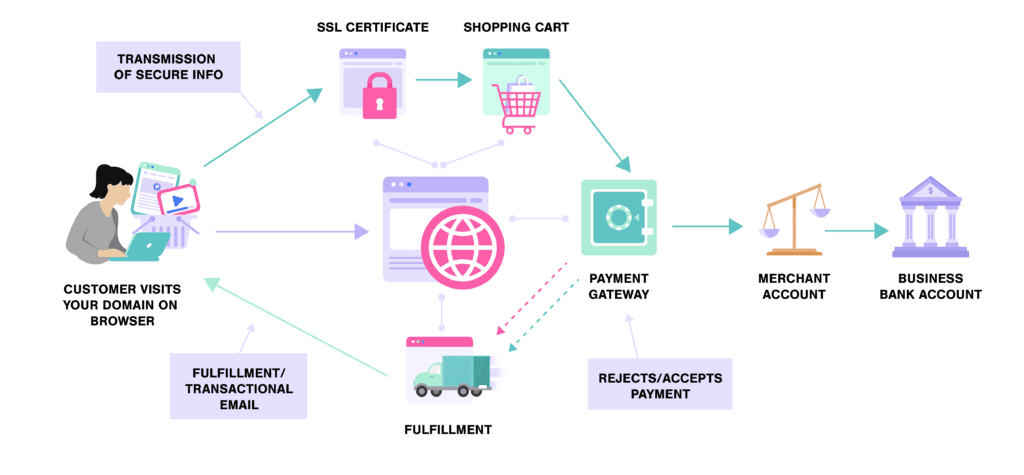
The ecommerce industry is huge. Data shows global ecommerce sales could reach more than $6.5 trillion by 2023, accounting for nearly a quarter of all retail sales worldwide. If you want to get in on the retail industry without investing in brick and mortar stores, commerce websites are the way to do it.
Let’s take a closer look at all the pieces of the puzzle that goes into online stores.
Ecommerce Website Platform – The Basis of Your Online Store
Your ecommerce platform – or ecommerce website – is the first connection point between you and the buyer. This is the place you offer your products or services for sale according to your chosen online business model.
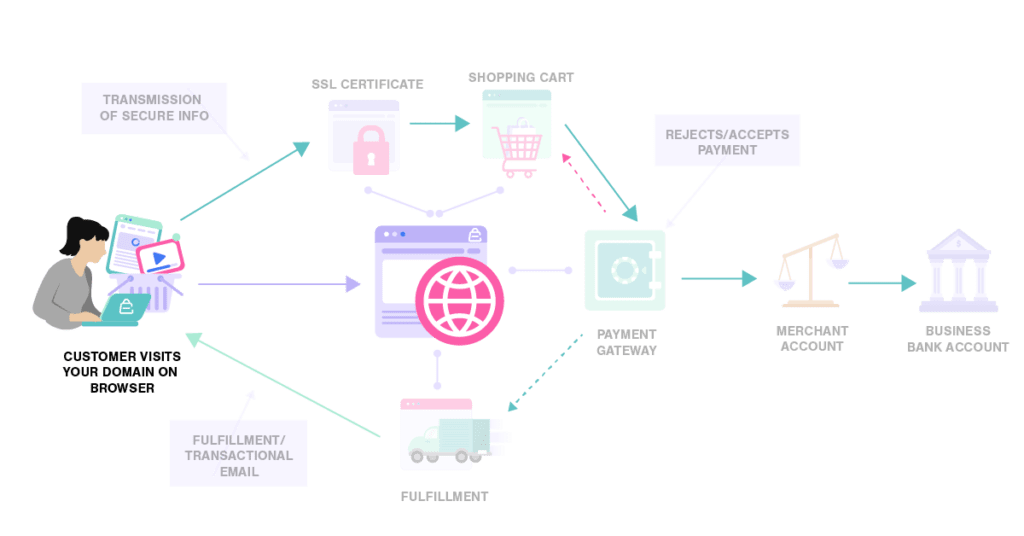
Your ecommerce website – or online store – is the place where your content and technology come together to make everything else happen. Attract customers to your ecommerce website through ecommerce marketing efforts. These include:
- Ecommerce search engine optimization (SEO)
- Content marketing
- Influencer marketing
- Email marketing
- Online advertising
- Listing your products in online marketplaces
- Using social media platforms to connect with your target audience
- Other ecommerce marketing methods
The good news is, there are plenty of ecommerce platforms and services online for you to build your ecommerce website. You don’t have to have any experience as a web designer to create online stores. Thanks to ecommerce solutions like Shopify, BigCommerce, Wix, and WooCommerce, you can set up your online store in just a few clicks. You’ll have to pay for these platforms, but they take care of maintaining your web server and other technical tasks.
If you need more tools and support than what the website builders offer, you can enlist the help of an ecommerce development expert to help you.
Depending on the state you operate from, the goods and services you’ll sell, and the suppliers you’ll work with, you may need a business license before you can start your ecommerce business. Talk to your local Chamber of Commerce, your Secretary of State, and conduct some research at the Small Business Administration. You’ll have local, state, and federal laws to comply with for any business you want to operate in the United States. Ecommerce businesses are no different.
I’m not a lawyer, so I can’t give you legal advice, but it’s a good idea to consult with an attorney who specializes in business formation. It’s also wise to talk to an accountant to make sure you keep your finances in order throughout the process. You’ll thank yourself at tax time.
The domain name is what people will use to access your ecommerce website. It needs to be easy to remember and easy to spell. Many companies opt to use their business name as the domain name to keep things simple.
Your domain name may be included for the first year, depending on the solution you choose to build your commerce business with.
SSL Certificate
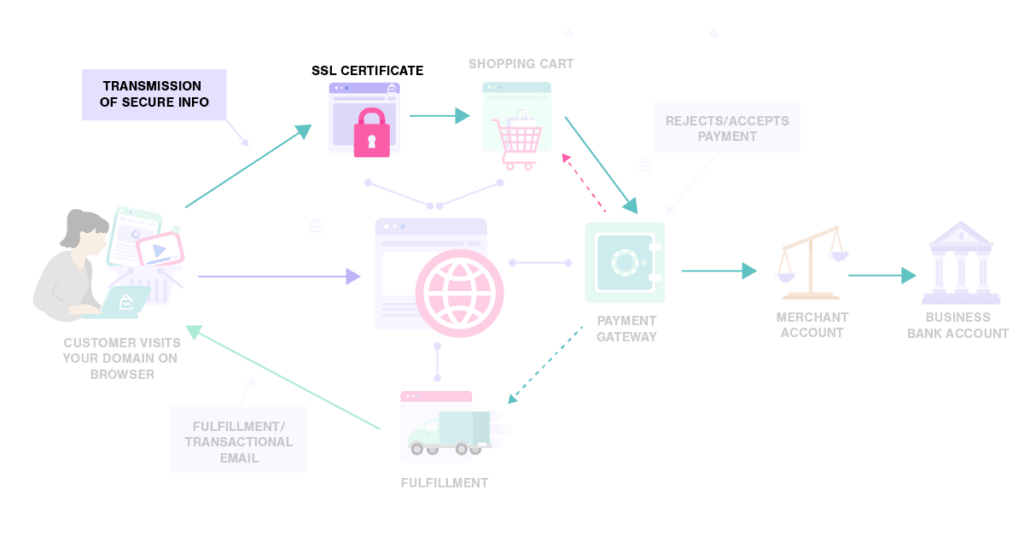
Once your website visitor reaches your website, the SSL certificate comes into play. This technology encrypts personal data that exists between your website server and the visitor’s browser.
The SSL certificate enables the secure transmission of credit card numbers via the internet. It helps consumers feel safe making online purchases. It helps protect sellers, too, because they know customer transaction data is secure.
Shopping Cart
The shopping cart allows customers to add products to a virtual cart. When they’ve finished shopping, it facilities the checkout process. It’s here the customer pays for their order, using their preferred payment method.
Without it, customers would have to call you to provide their credit card information over the phone. This is time-consuming for both you as the business owner and the consumer. The cart also calculates sales taxes, shipping costs and captures the customer’s billing and delivery addresses.
Your ecommerce platform has this piece built-in, so it’s not something you have to set up separate from the rest of your ecommerce store.
Payment Processor
Chances are, you’ve heard the terms payment gateway and payment processor used interchangeably. The truth is that while they both have a role in your ecommerce site, they aren’t the same thing.
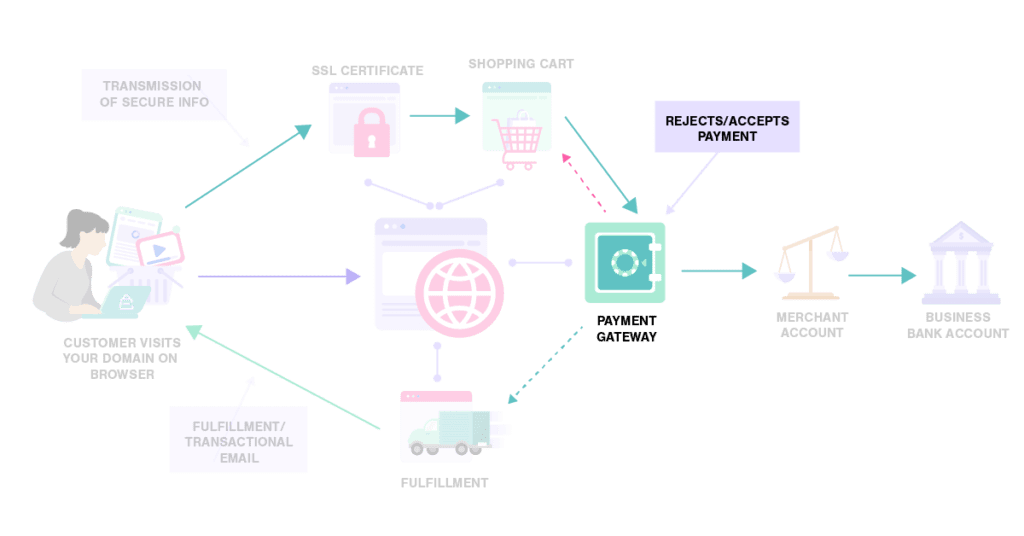
Four parties are part of every single credit card transaction, whether processed in a physical store or online:
- The merchant (your online business)
- The customer
- The bank that issued the customer’s debit or credit card
- The bank that collects the funds from the customer’s bank
The payment processor starts the transaction between you, the issuing bank, and the acquiring bank. It’s the payment processor that generally provides any machines or other equipment you’d use to accept credit card payments in person.
Payment Gateway
The payment gateway is the tool that transmits the online payment data to the processor so that the transaction may continue. It’s what authorizes payments for “card-not-present” situations like ecommerce. It’s basically the online equivalent of the physical equipment you’d use to take credit cards in person.
The payment processor facilitates the transaction. The payment gateway communicates whether the transaction is approved or declined. Luckily, ecommerce platforms have gateways and processors built-in, so you don’t have to worry about this too much. You simply choose the option that works best for you.
As you may your choice, you’ll want to consider the transaction and payment processing fees involved. You may pay a monthly fee on top of transaction fees. Consider your sales volume as you make your selection.
Transaction Email
Thanks to internet commerce automation, after the payment gateway processes the transaction, your ecommerce platform will send an email to the customer. This email indicates that your ecommerce site did receive the order. It often suggests that you will send a second email once the order has been fulfilled. This way, the buyer always has access to their order tracking information.
If the transaction was denied, some systems might not email the customer. Instead, they may display a message on the checkout screen with error details. This way, consumers can correct the error and process the transaction again. Sometimes, it’s a user error – such as mistyping the CVV code on the back of the card or entering the wrong expiration date.
Some systems may opt to send a “problem with your order” type email to let customers know the payment did not go through.
In the case of selling digital products, the transaction email will include links to download the purchased product.
Order Fulfillment
When it comes to order fulfillment, you have a variety of options. You can fulfill it yourself, holding inventory in your home or office. When a customer places an order, you pull the product, pack and ship it, and then send the tracking information.
You can enter the tracking information into your ecommerce platform’s inventory management system and update the status, so the email automatically goes to the customer. This is often a hassle for many small ecommerce sites that are just getting started.
You can use a dropshipping business model, where you order products from a third-party vendor, who ships them directly to your customer as if the order had come from you.
Alternatively, you can use a third-party order fulfillment service like Fulfillment by Amazon, Red Stag, or FedEx Fulfillment. In this scenario, you’ll pack your items, ship them to the warehouse as instructed, and the fulfillment company will handle the packing and shipping of the orders on your behalf.
Merchant Account
All online retailers have to use a merchant account. It’s the “in-between” account that holds the money for approved e commerce transactions before being transferred into your business bank account. In the past, before electronic commerce became so popular, merchant accounts were expensive to obtain. Now, you don’t have to worry about getting a separate one if you don’t want to. Many ecommerce platforms include a merchant account and their payment gateway with payment processing features, so it’s all together.
You will not have direct access to the funds in your merchant account. Any funds deposited from the customer’s credit or debit card are deposited into the merchant account once the transaction is approved. It will automatically move into your bank account within one to two business days unless you’ve set up a different transfer schedule.
Business Bank Account
Once the money has gone through the gateway and merchant account, it winds up in your hands through your business bank account. For ease of transactions and also to keep track of your sales, it’s best to have a separate business bank account for all the transactions from your ecommerce store.
The electronic business commerce process contains many steps, from the point the customer buys from your website to when the money winds up in your hands. On the bright side, the ecommerce process is a quick transaction option to use. This online sales method provides an easy way to reach customers around the globe, sell your goods and services, and get paid for the commerce transaction.
What is Ecommerce Business?
Let’s take a closer look at the different ecommerce business models.
Retail
Retail sales in an online store are the sale of a product directly from the seller to the buyer. There is no middle party in the transaction. This is a B2C relationship. New ecommerce sellers often use the retail approach. There are fewer people involved than some other methods. The setup is more basic and easy to understand for new ecommerce sellers.

Wholesale is the sale of products in bulk. The seller purchases wholesale bulk products from another seller, in a B2B transaction. Then, they turn around and sell the products to another business. The final purchasing party then sells the wholesale items to its consumers via their ecommerce site, at a higher price point, to generate profit.
Dropshipping
Dropshipping is a three-party system. The buyer purchases a product from the seller. The seller doesn’t send the product directly. A third party (usually the supplier) sends the product directly to the buyer. The buyer never knows it was shipped this way. Drop shippers generally use branding to make it look like the order came from the seller. Sellers don’t have to deal with packaging, shipping, or even sending order status emails. That’s why it’s great for small businesses that don’t have the room to store inventory.
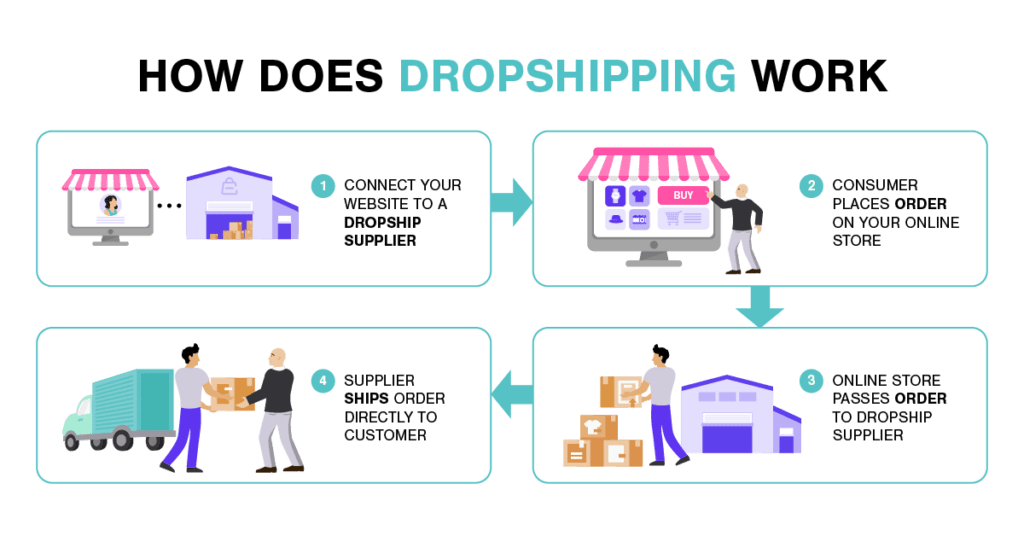
White Labeling
With white labeling, you take another company’s successful product and selling it with your own package and label. However, you have to find a product that allows for white labeling. You don’t manufacture the product, but sell it in your online store as if it were your own.
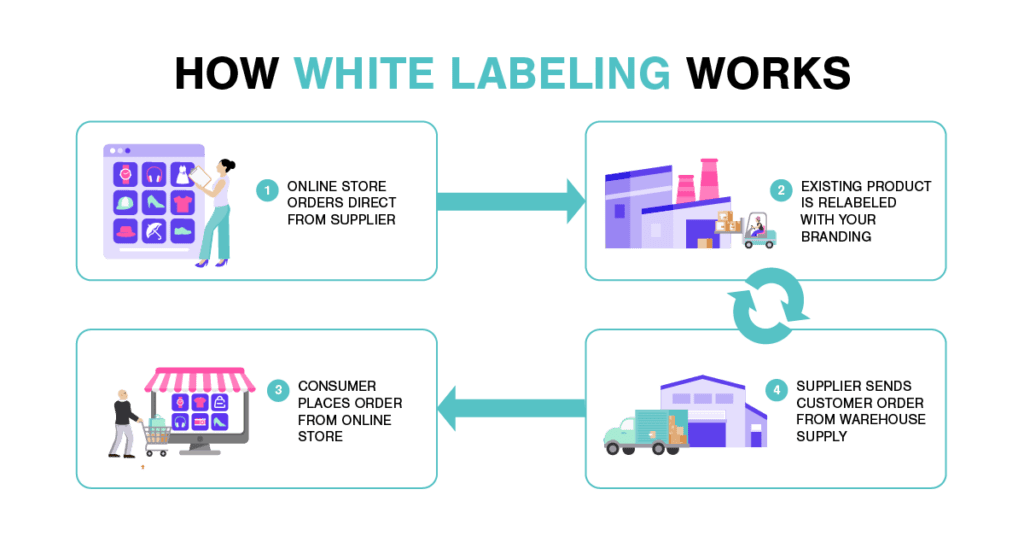
This is an easy way to sell products online. Typically, white label products are popular yet generic enough to warrant creating your own brand. Examples of white labeling products include tote bags, stainless steel water bottles, and phone cases, to name a few.
Print On Demand
Print-on-demand, or on-demand printing, is an ecommerce model featuring ecommerce personalization. After the customer orders the product via your online store, the item is printed. Print on demand products are popular for company swag and party favors.
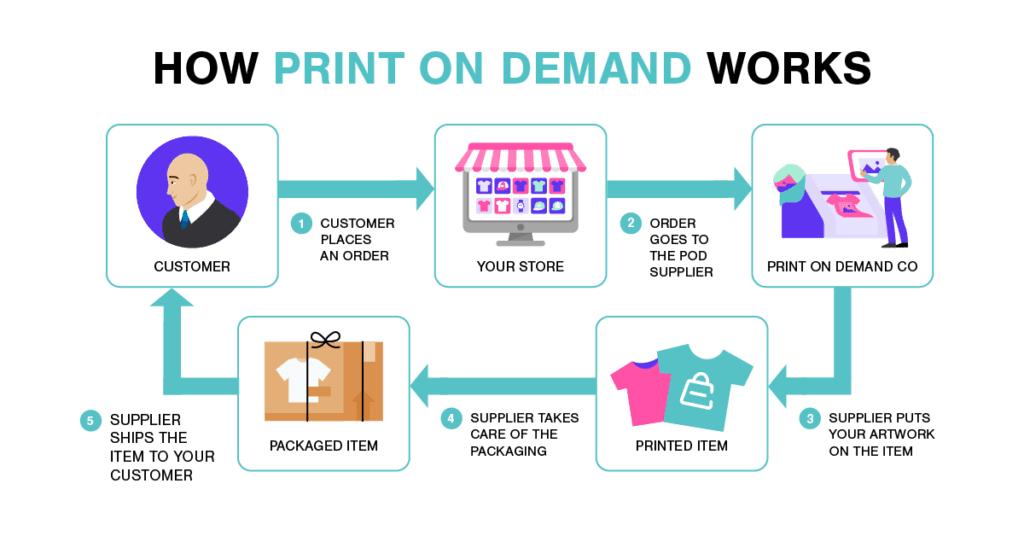
Private Labeling
Private labeling uses a third-party manufacturer but sells the product with the seller’s brand name. Like white labeling, this only works with certain products where it is allowed. One of the most common types of ecommerce businesses is private label rights content. From articles to videos, ebooks, and even full courses, creators sell their product with private label rights, to others. Buyers rebrand and price the product for sale directly to their customers.
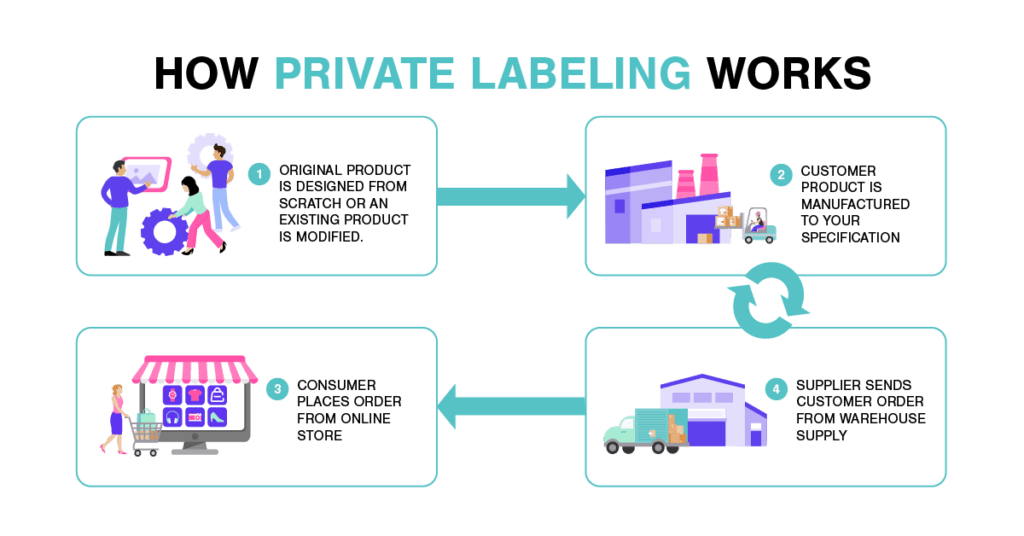
Affiliate Marketing
Affiliate marketing uses other brands, bloggers, or businesses to promote your products for you. It’s essentially a sales team out there working to sell your product – and you only pay them when they send you leads or sales. That’s what makes it one of the most popular ecommerce methods.
Affiliate marketers build their own websites and social media assets. They show up in a Google search for terms related to your product or service. They use a special link to your site that tracks the traffic they send your way.
Affiliate marketers may promote multiple products to build additional revenue streams. You can find a variety of affiliate programs to work with. It’s a great way to expand the reach of their products and services.
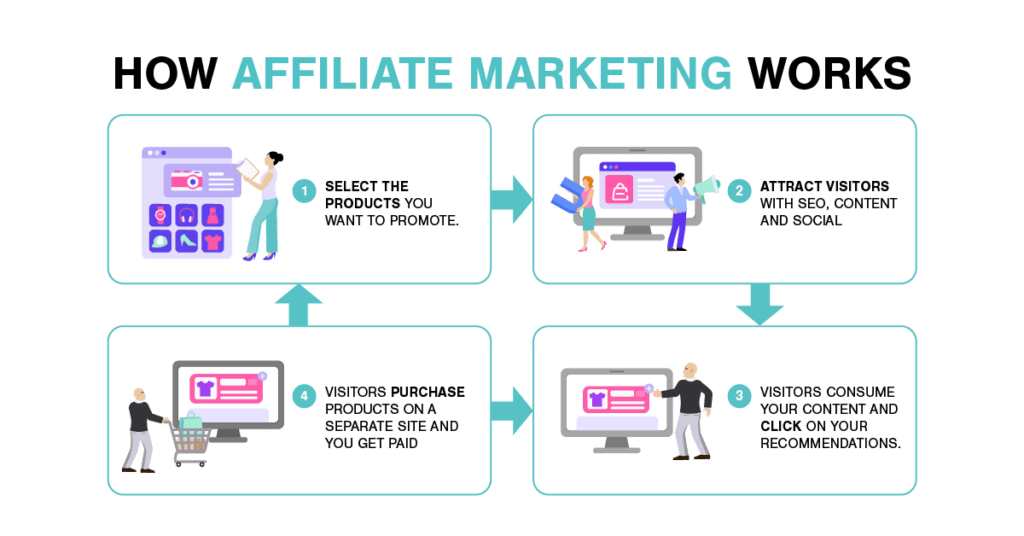
Each of these ecommerce models consists of a different supply chain. You need to research what’s best for your online store. Also, you don’t have to choose just one type of ecommerce business. Some online sellers choose retail but also use affiliate marketing. This helps to reach more customers.
Product Business Models
In the ecommerce business, there are specific product business models. These classify your overall product category and types of ecommerce in your store. You may use digital or physical products.
Some ecommerce businesses focus on one type of product. Others offer a wide array of products to their consumers and their online shopping needs. You’ll need to know what business model you want to use with your online store to choose the right marketing channel.
Single Product
A single product is a product that has one focus and use, such as Spanx or Crocs. It is a unique product available in different sizes and colors. This product often sees high margins. This type of B2C ecommerce store is easy to manage. The downside is that it may have limited appeal and won’t work for affiliate marketing.
Boutique
A boutique product in your ecommerce store covers a single category, such as Flowers.com or White T-Shirt Company. This type of business-to-consumer model is good for newbies as it’s easy to manage. Negatively, with this b2c business model you have limited cross-selling capabilities.
Multiple Categories
The multiple category option features retailers that offer many different product categories. Examples of these businesses include Wayfair, Best Buy, or Macy’s. This business model is ideal for existing brands with physical store locations. This approach has wide appeal to people shopping online and upselling potential. It’s hard to get traction and can be difficult to manage through your store.
Subscription
Subscription business models are businesses that customers subscribe to and receive goods and services. Examples include Dollar Shave Club and Blue Apron. This is an ideal business-to-consumer model for specialty and convenience items. It’s good for recurring revenue, but it requires a lot of trust.
Understanding your options for your ecommerce website makes the decision-making process that much easier.
As tempting as it may be to jump in and get your business online right away, it’s critical to research your approach. You’ll also need to research the products or services you’ll sell. This is true whether you create them yourself, or rely on existing solutions.
Types of Products
Product types, like business models, are wide and varied. Focusing your online store on a specific type of product helps you narrow down types of ecommerce options and fine-tune your business plan. Here are some product categories to consider when deciding what to sell online with this sales method:
Convenience
A convenience product is an item that’s purchased with little thought as it’s a routine purchase. This store product appeals to a large target audience and is purchased often, such as shampoo or razors.
Shopping
A shopping product is an item that requires more thought. Consumers are more likely to do research before buying a shopping product from your store. They’re more likely to compare it with other similar products, such as backpacks and apparel.
Specialty
A specialty product is an item where the customer accepts no substitute. With this type of product, consumers are interested in the quality. They are often concerned with brand image, for example, a luxury watch or high-end handbag.
In some situations, you can take a convenience product like body wash, and make it into a specialty product. Lush Cosmetics is a perfect example. They’ve created specialty products by using vegan or cruelty-free ingredients, purchased from organic farms. The products are all handmade in batches. The brand takes massive action to protect the environment. They use naked packaging, have a charity pot lotion, and a pot recycling program.
Though the international company has brick-and-mortar stores, many customers prefer the online shop. Many customers aren’t close to a physical store. The brand has kept up with trends by adding a buy online and pick up in-store option.
Consider the product options for your online store and choose the type that fits your website best. One of the biggest benefits of ecommerce is the flexibility it offers. It’s possible to combine multiple types of ecommerce. You can reach more customers and expand your revenue potential.
Ecommerce Examples: What a Successful Online Store Looks Like
I’m skipping obvious examples like the biggest online marketplace (Amazon), and others like it.
You can be a successful online retailer without having the kind of market share that these marketplaces do. You can even leverage them to help reach more of your target customers.
Zenni Optical

Zenni Optical is a highly successful ecommerce store that shows nearly everything works as an online purchase. At the dawn of ecommerce stores, buying your eyeglasses over the internet wasn’t on anyone’s radar.
Zenni Optical was founded in 2003, making it one of the older brands out there. In September 2020, this ecommerce website reported they were on track to hit $325 million in online sales. That’s rapid growth from $75 million in 2019. While the pandemic played a role in the increase, Zenni is popular because they put customers first. They make it easy to test what a pair of glasses would look like on your face. If the glasses don’t look or fit as expected, you can return them for store credit. Zenni provides a quality product at a fraction of what you’d pay at your local optometrist’s office.
Purple Mattress
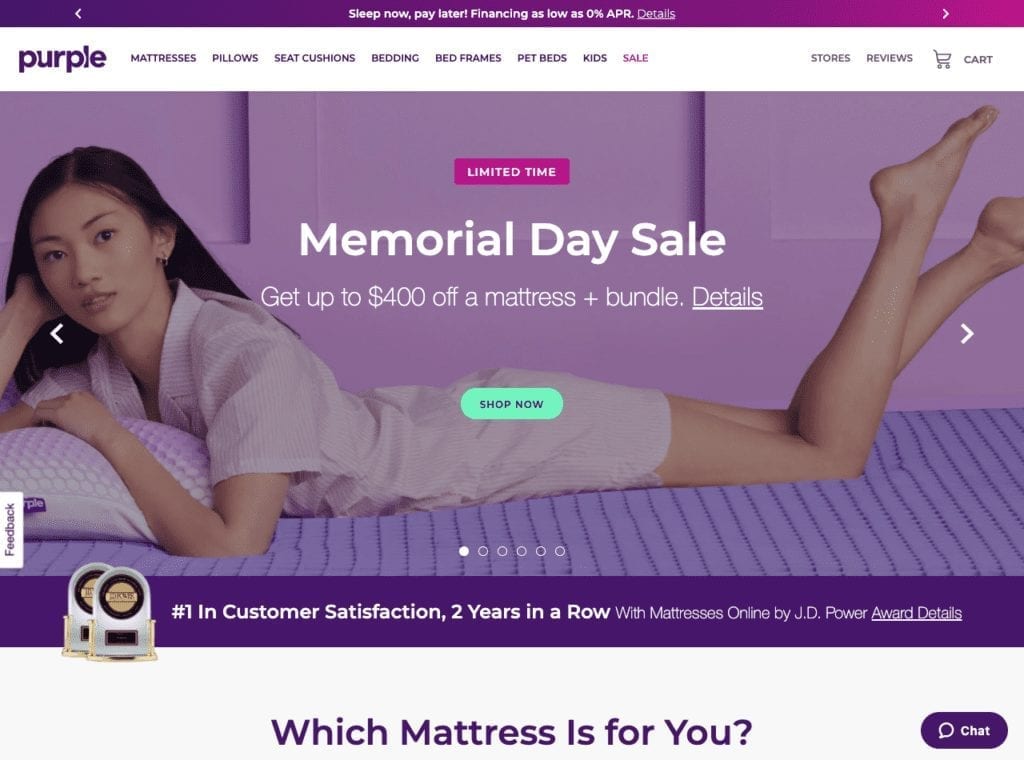
Like eyeglasses, mattresses were once something people would never dream of buying online. Purple Mattress is one of many startups that have proven you don’t have to go try a bunch of mattresses in-store to find something that works for you. And they started a trend – CBNC reported in 2019 there are an estimated 175 online “bed in a box” companies that sell online, exclusively. Purple is one of the brands leading the pack but is the only public bed-in-a-box company.
In 2020 Q4, Purple reported a 39.9% net revenue increase to $173.9 million, compared to 2019 Q4. The company also reported direct-to-consumer revenue increased 57%, with wholesale revenue increasing 9%.
Lume Deodorant
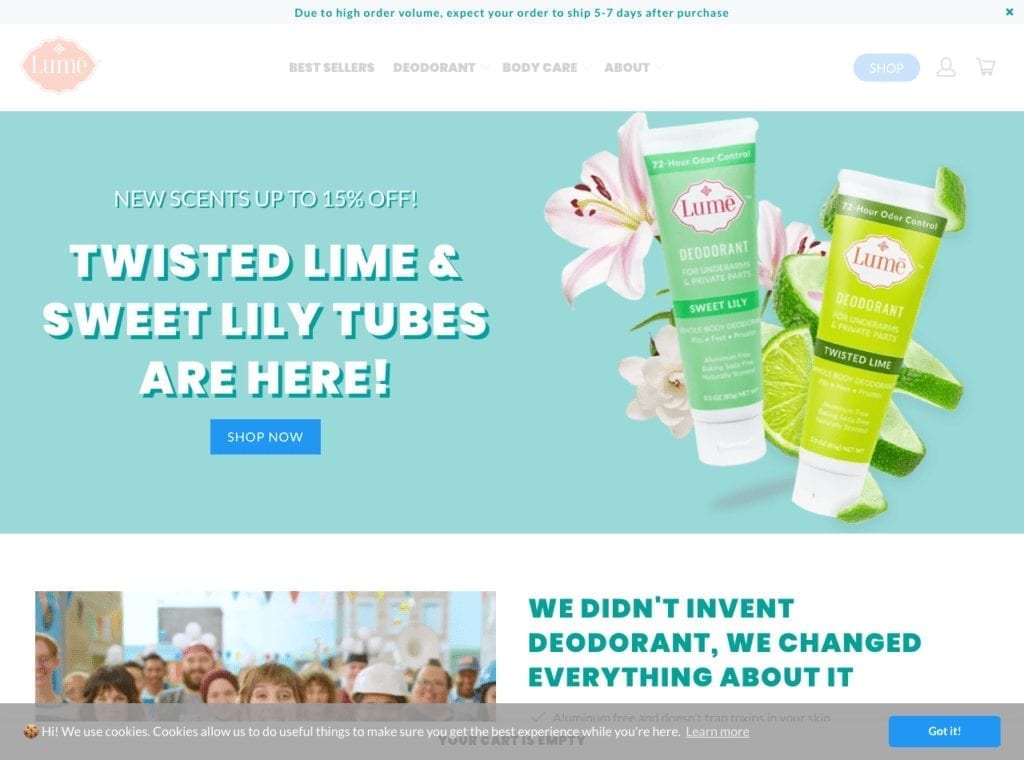
Lume Deodorant officially launched on October 1, 2017, and has become a wild success. The product generates an estimated $6.86 million in online sales as of 2020. Exclusively sold online, at their official website, and on Amazon, products range from $12.99 to $24.99. Popular because it’s an aluminum-free, cruelty-free product safe for use anywhere on the body (for both men and women), this brand shows all you need is a good product, an ecommerce website, and an online advertising and marketing plan. The brand is known for its catchy social media ads, such as the one shown here.
Harry’s
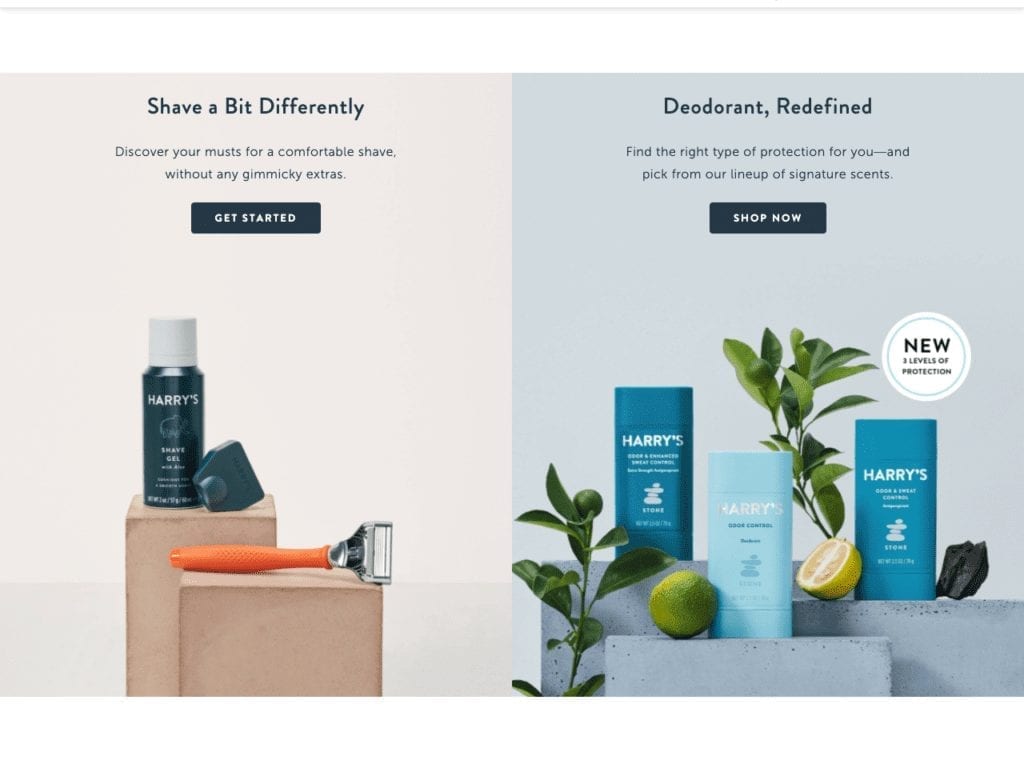
Harry’s is an online razor subscription club, similar to Dollar Shave Club. In 2019, the company reported 35% year-over-year growth. At this volume, it’s only growing faster than Dollar Shave Club, it’s growing 3x faster than the industry average. As the third-largest brand in online blades and razor sales, it goes to show that you really can find nearly anything you want online. It’s worth noting, though, that like Dollar Shave Club, Harry’s has made its way into retail partnerships with brands like Target and Walmart.
What You Need for a Profitable Ecommerce Website
Today’s internet users are savvier than ever, so that means you need more than the necessary site functionality to make the most of your online efforts. Whether you’re selling products or services online, you need a few things to support you in your journey.
Solid Ecommerce Platform
There are many ecommerce solutions out there to choose from. You can create an online store from scratch with a platform like WordPress and use plugins to add the features you need to sell online. Or, you can an ecommerce platform like Shopify or BigCommerce, which is built solely for ecommerce websites. No matter what you choose, the technical structure that supports your commerce transactions is crucial. Without a sturdy foundation, none of the other work that goes into it matters.
The best ecommerce platforms are those that give you the flexibility to add support for features as you need them. You want something that lets you start small, but can scale with you as you grow.
Support for Mobile Commerce
On today’s World Wide Web, online shoppers expect to be able to make purchases from their smartphones and tablets. If online consumers can’t shop from their mobile devices, then you’re basically sending them to other businesses that make online purchases easy.
Inventory Management
In the ecommerce industry, managing inventory is a crucial part of the business, unless you’re selling digital products. Without it, you could easily oversell a product – especially if you have to share inventory across a traditional store and an online store, too, or sell the same inventory across more than one online market. There are many businesses online that use paid or free inventory software that integrates with their store, to make it easy to keep track of stock. It automatically takes an item out of stock so that you don’t end up with unhappy customers.
Business and Marketing Plan
No matter what niche you decide to go into within the ecommerce industry, you’ll have some competition. To make the most of the ecommerce traffic that heads your way, you’ll need a good plan.
That means, taking the time to do your research. Look at what the competition is doing and build a plan that puts you right alongside them. You may not have the capital that some of these brands do, but to build ecommerce sales, you need a plan.
Think about:
- What you’ll sell and how you will sell it.
- How your brand or products are different from what’s already out there.
- The types of social media and online advertising you’ll use.
- Short-term and long-term goals
Ecommerce Business Opens Up a World of Sales Opportunities
You now have an overview regarding what is ecommerce pertaining to the selling of goods and how this online business scenario works with customers. Now’s the time to brainstorm ideas on how to get these types of ecommerce products out to the consumer. Ecommerce business enables online retailers to reach consumers across the globe through an ecommerce store and improve sales numbers while attracting customers.
The most successful ecommerce retailers have done their homework – and they go into business with a value proposition that makes them stand out from the competition. This is one sales method you don’t want to miss out on!